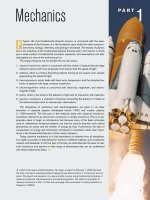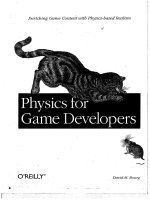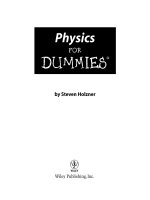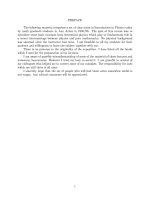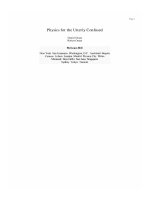Physics for Aero dynamicsAERODYNAMICS
Bạn đang xem bản rút gọn của tài liệu. Xem và tải ngay bản đầy đủ của tài liệu tại đây (2.81 MB, 112 trang )
For Training Purposes Only
ATA
AERODYNAMICS
Page 1
FUNDAMENTALS
AERODYNAMICS
PHYSICS FOR AERODYNAMICS
1.
Physics for Aerodynamics
The laws of physics that affect the aircraft in flight and on the ground are described using the international SI system.The SI system is based on the metric
system and must be used by law throughout the world.
You need to use conversion tables for the English or American systems. You
can find conversion tables in the appendix of most technical documentation.
The laws of physics are described by fundamental units and basic quantities.The fundamental units can not be defined in other quantities.The basic
quantities are defined in fundamental units.
Speed, for example, is a basic quantity. It is defined by the fundamental units
distance and time.
Speed, denoted by V is distance, denoted by m over time, denoted by s.
There are seven fundamental units in physics -- mass, length, time, temperature, current, mol number and the intensity of light.
The fundamental units used in aerodynamics are mass, length, time and temperature.
Aerodynamics Lesson 1
1.1.3. Time
The unit of measurement for time is seconds, denoted by s. Originally this was
based on the length of a day. However not all days are exactly the same duration so the second is now defined as the time it takes for a certain number of
energy changes to occur in the caesium atom.
1.1.4. Temperature
The unit of measurement for temperature is kelvin, denoted by K. Zero kelvin is
called absolute zero because it is the lowest temperature possible.
The kelvin scale starts at zero and only has positive numbers.
One kelvin is the same size as one degree Celsius.
1.1. Fundamental units
For Training Purposes Only
1.1.1. Mass
The unit of measurement for mass is kilograms, denoted by kg. The mass of
one kilogram is defined by a piece of platinum alloy at the office of weights and
measurements in Paris.
The mass of one kilogram is also the volume of one liter of pure water at a
temperature of four degrees Celsius.
Mass is not the same as weight. The astronauts flying around in their space
labs have no weight but their bodies have a mass.
1.1.2. Length
The unit of measurement for length is meters, denoted by m.
The meter was established as a standard unit of length by a commission set up
by the French government in 1790.
A meter is more precisely defined as a certain number of wavelengths of a particular colour of light.
Page 2
FUNDAMENTALS
AERODYNAMICS
PHYSICS FOR AERODYNAMICS
For Training Purposes Only
Aerodynamics Lesson 1
Figure 1
Page 3
AERODYNAMICS
PHYSICS FOR AERODYNAMICS
FUNDAMENTALS
Aerodynamics Lesson 1
1.2. Speed and acceleration
1.2.1. Speed and velocity
Speed is the distance that a moving object covers in a unit of time. For example, we can say that an aircraft has a speed of 500 kilometers per hour.
Speed is denoted by V.
Velocity is the distance that a moving object covers in a given direction in a unit
of time. We can say that an aircraft has a velocity of 500 kilometers per hour
northward.
Velocity is also denoted by V.
1.2.2. Acceleration
For Training Purposes Only
Acceleration is the change in velocity divided by the time during which the
change takes place.
You can see that the velocity changes from 100 m/s to 150 m/s during this ten
second period.
In this example the acceleration is 50 m/s per ten seconds. This is equal to five
meters per second per one second which is 5 m/s2. Acceleration is measured
in meters per square second ( m/s2 ).
Acceleration is denoted by a.
Page 4
FUNDAMENTALS
AERODYNAMICS
PHYSICS FOR AERODYNAMICS
For Training Purposes Only
Aerodynamics Lesson 1
Figure 2
Page 5
FUNDAMENTALS
AERODYNAMICS
PHYSICS FOR AERODYNAMICS
1.2.3. Acceleration due to gravity
1.3. Force and weight
We begin our look at force with an experiment. You can see that our friend is
standing on a weighing scale in an elevator and observing his weight ( Fig. below, left ).
There is no change in weight if a body stays at rest or if it moves with uniform
velocity.
But what happens to the weight if the elevator accelerates as it moves upward?
As the elevator accelerates there is an additional force which increases the
weight
Force is measured in Newtons. The term deca--Newton is used in all technical
manuals for force and for weight.
Weight is one kind of force. It is mass multiplied by the acceleration due to
gravity. You know that gravity is the attraction exerted on any material towards
the center of the earth.
Weight is also measured in Newtons ( Fig. below, right ).
For Training Purposes Only
A special form of acceleration is acceleration due to gravity. An object, such as
this ball, which falls freely under the force of gravity has uniform acceleration if
there is no air resistance.
Acceleration which is due to gravity is denoted by g.
The value of this acceleration varies across the earth’s surface but on average
it is nine point eight meters per square second. For ease of calculation ten meters per square second is often used.
Aerodynamics Lesson 1
Page 6
FUNDAMENTALS
AERODYNAMICS
PHYSICS FOR AERODYNAMICS
For Training Purposes Only
Aerodynamics Lesson 1
Figure 3
Page 7
AERODYNAMICS
PHYSICS FOR AERODYNAMICS
FUNDAMENTALS
Aerodynamics Lesson 1
1.4. Work and Power
1.4.1. Work
For Training Purposes Only
Work is done when an object is moved over a distance. It is force multiplied by
distance. Work = N x m.
Work is denoted by joule and is measured in Newton meters.
You can see that the object with a force of six hundred Newton is moved a distance of thirty meters.
The work is six hundred Newton multiplied by thirty meters which is eighteen
thousand Newton meters.
Page 8
AERODYNAMICS
PHYSICS FOR AERODYNAMICS
FUNDAMENTALS
Aerodynamics Lesson 1
1.4.2. Power
For Training Purposes Only
Power is work over time or more specifically force multiplied by distance over
time.
Power is measured in Watts which is Newton meters per second.
You probably know the term horse power. When steam engines were first used
their power was compared to the power of horses because they were used for
work which was previously done by horses. Now the international SI system
uses watts and kilowatts instead of horsepower.
You can see that the object with a force of 600 N is moved a distance of 30 m
in 10 seconds.
The power is six hundred Newton multiplied by thirty meters divided by ten seconds which is 1800 watts or 1.8 kilowats.
Page 9
FUNDAMENTALS
AERODYNAMICS
PHYSICS FOR AERODYNAMICS
Aerodynamics Lesson 1
1.5. Pressure
1.5.1. Static pressure
Pressure is the force acting on a unit of area.
It is denoted by Pascal ( Pa ) and measured in Newtons per square meter
( N/m2 ).
Static pressure acts equally in all directions. It is denoted by a small ’p’ and
measured in Newtons per square meter ( N/m2 ).
Static pressure is calculated as height multiplied by density multiplied by gravity. Pstat. = h x H x g.
1.5.2. Dynamic pressure
” bar ”
and has the unit
daN
cm 2
1 bar = 1 daN2
1 cm
1 bar = 100 000 Pa
For Training Purposes Only
Dynamic pressure acts only in the direction of the flow.
It is denoted by a small ’q’ and sometimes called q pressure and, like static
pressure, measured in Newtons per square meter ( N/m2 ).
Dynamic pressure is calculated as half the density multiplied by the velocity
squared. q = ½ x H x v2 .
The static pressure for aircraft technical systems is denoted by ’bar’ and measured in decaNewtons per square centimeter ( daN/cm2 ).
One bar is equal to one hundred thousand PASCAL.
The STATIC PRESSURE for technical systems e. g. for AIRCRAFT HYDRAULIC SYSTEMS is denotet by
Page 10
FUNDAMENTALS
For Training Purposes Only
AERODYNAMICS
PHYSICS FOR AERODYNAMICS
Aerodynamics Lesson 1
H
H
q = ½ x H x v2
p=hxH xg
Figure 4
Page 11
AERODYNAMICS
PHYSICS FOR AERODYNAMICS
1.6. Sound waves
Aerodynamics Lesson 1
Now you know that the speed of sound depends on the temperature. For example if the temperature on a Summer day is 15E C, which is 288 K, then we
calculate the speed of sound to be 339.4 m/s.
If the temperature decreases in Winter to - 50E C, which is 223 K, then the
speed of sound is 298.6 m/s.
The speed of sound is less at high altitudes because the temperature is lower.
For Training Purposes Only
Sound waves are the same as pressure waves.
The speed of sound is the speed of the small pressure waves which occur
when you ring the bell.
The speed of sound is denoted by ’a’.
In the formula for the speed of sound, the number twenty is an approximation
of the total of all the relevant constant values and ’T’ for temperature represents the only variable value.
Note that the temperature must be expressed in Kelvin!
FUNDAMENTALS
Page 12
FUNDAMENTALS
AERODYNAMICS
PHYSICS FOR AERODYNAMICS
Aerodynamics Lesson 1
For Training Purposes Only
a = 20 × 223 = 298.6 m
s
Figure 5
Page 13
FUNDAMENTALS
AERODYNAMICS
PHYSICS FOR AERODYNAMICS
Aerodynamics Lesson 1
1.6.1. Speed of sound
Now let’s see what happens if the source of the sound moves, for example if
we have an aircraft flying. First we see an aircraft flying at a speed which is
below the speed of sound.
You can see that the pressure wave moves ahead of the aircraft and also behind it.
Next we see an aircraft flying at the same speed as the speed of sound.
The pressure wave cannot escape at the front of the aircraft and we get a big
pressure wave forming. This pressure wave is known as a shock wave.
Finally we see an aircraft flying at a speed which is above the speed of sound.
In this case the pressure waves increase behind the aircraft and shock waves
form outside the periphery of the pressure waves.
Now you know that different aircraft speeds affect the sound waves.
For Training Purposes Only
Below the speed of sound
V<1M
At the speed of sound
V =1 M
Above the speed of sound
V >1 M
Page 14
FUNDAMENTALS
AERODYNAMICS
PHYSICS FOR AERODYNAMICS
Aerodynamics Lesson 1
1.6.2. Mach number
For Training Purposes Only
The pilot must know the relationship between the speed of the aircraft and the
speed of sound.
On most aircraft the pilot must make sure that the speed of the aircraft is less
than the speed of sound.
Now let’s see what happens when an aircraft flies at a constant speed but in
different temperatures. In this example the aircraft is flying at a low altitude with
a speed of 300 m/s.
You can see that the aircraft speed is below the speed of sound at this altitude.
We assume the speed of sound is 330 m/s.
Now the same aircraft is flying at an altitude of 10 km. The aircraft continues to
fly with a speed of 300 m/s.
At this higher altitude the temperature is lower and the speed of sound decreases to 300 m/s.
Now the aircraft is flying at the speed of sound and you can see that shock
waves are produced.
A special indication known as the Mach number, ’M’ is used to keep the pilot
informed of the relationship between the speed of the aircraft and the speed of
sound.
The Mach number is the speed of the aircraft divided by the speed of sound.
In our example the aircraft flying at an altitude of 10 km has a Mach number of
one ( M = 1 ). A Mach number of one indicates that the aircraft is flying at the
speed of sound.
300 M
S
Page 15
AERODYNAMICS
PHYSICS FOR AERODYNAMICS
FUNDAMENTALS
Aerodynamics Lesson 1
1.6.3. Sound regions
For Training Purposes Only
These graphics illustrate the three sound regions which are defined by the
Mach numbers. In the subsonic region all speeds around the aircraft are below
the speed of sound. This is the region up to the critical Mach number.
In the transonic region some speeds around the aircraft are below the speed of
sound and some are higher than the speed of sound. This is the region between the critical Mach number and 1.3 Mach.
Finally we have the supersonic region. Here all speeds around the aircraft are
higher than the speed of sound. This is the region at Mach numbers higher
than 1.3 Mach.
That’s all we have to say about the speed of sound in this segment. You will
see more on this subject in the chapter for high speed flight.
Page 16
FUNDAMENTALS
AERODYNAMICS
PHYSICS FOR AERODYNAMICS
For Training Purposes Only
V < Mcrit
Subsonic
Aerodynamics Lesson 1
Mcrit < V < 1.3 M
Transonic
V > 1.3 M
Supersonic
Figure 6
Page 17
AERODYNAMICS
PHYSICS FOR AERODYNAMICS
FUNDAMENTALS
Aerodynamics Lesson 1
1.7. Atmosphere
To understand aerodynamics we need to know something about the atmosphere where flying happens.
The atmosphere is the whole mass of air extending upwards from the surface
of the earth.
Air is a mixture of several gases. Pure, dry air has approximately 78% nitrogen,
21% oxygen and one percent other gases such as argon and carbon dioxide.
For practical purposes it is sufficient to say that air is a mixture of four fifths
nitrogen and one fifth oxygen.
The atmosphere has many layers.
The troposphere is the lowest of these layers. In the troposphere we have
clouds and rain and many different weather conditions.
There are no rain clouds in the stratosphere and the temperature does not
change as the altitude increases.
The tropopause is the name given to the boundary between the troposphere
and the stratosphere. The tropopause has different heights around the earth. It
is approximately eight kilometers over the north and south poles and sixteen
kilometers over the equator.
TROPOSPHERE
For Training Purposes Only
21% Oxygen
78% Nitrogen
Page 18
AERODYNAMICS
PHYSICS FOR AERODYNAMICS
FUNDAMENTALS
Aerodynamics Lesson 1
1.7.1. ICAO Standard Atmosphere ( ISA )
For Training Purposes Only
You know from watching the weather forecast that temperature, pressure and
density vary quite a lot in the troposphere.
These variations must be reduced to a standard so that we have a basis for
comparing aircraft performance in different parts of the world and under varying
atmospheric conditions.
In order to have a reference for all aerodynamic computations, the International
Civil Aviation Organisation ( ICAO ) has agreed upon a standard atmosphere
called ISA ( ICAO standard atmosphere). The pressure, temperature and density in the standard atmosphere serve as a reference only. When all aerodynamic computations are related to this standard, a meaningful comparison of
flight test data between aircraft can be made
Now let’s take a look at the temperature, pressure and density of the ISA at
sea level and at high altitudes.
You can see the standard sea level values for temperature, density and pressure. Note that the standard altitude for the tropopause is eleven kilometers.
Under standard conditions temperature decreases with altitude at a rate of
6,5E C per 1000m, or 2E C ( 3.5E F ) per 1000 foot.
This gives a standard temperature of -56,5E C at the tropopause.
There is no change in temperature in the stratosphere.
The density and pressure decrease gradually with altitude.
The graph shows the basic tendencies for temperature, pressure and density.
You can find more precise information in the standard atmosphere tables which
you can usually find in the appendix of technical documentations.
These are the ISA conditions for sea level:
Temperature T : 288 K = 15E C
Density H : 1,225 kg/m3
Pressure P : 1013,25 hPa
Page 19
AERODYNAMICS
BASIC AERODYNAMICS
2.
Aerodynamics Lesson 2
Basic Aerodynamics
In this chapter we look at some of the basic principles of aerodynamics in the
subsonic region.
In the subsonic region the speed is so slow that a flying body does not compress the air. We say that the air is incompressible in the subsonic region.
2.1. Continuity equation
Now let’s have a closer look at the behaviour of the air streamlines.
You can see that the streamlines are parallel to each other if there is no disturbance.
The airflow between the streamlines is similar to the flow in a closed tube. You
will see later that we use the term stream tube.
Here you see the flow pattern in a tube with different diameters.
For Training Purposes Only
FUNDAMENTALS
The area of the cross--section at point A2 is five square centimeters and the
velocity of the airflow at this point is 40 m/s.
The continuity equation states that the velocity of the airflow is inversely
proportional to the area of the cross section of the tube as long as density remains constant !
For example if the area of the cross section is halved then the velocity of the
airflow is doubled or if the area is four times smaller then the velocity is four
times greater.
We use the term defuser outlet when the diameter increases and the velocity
decreases and the term jet outlet when the diameter decreases and the velocity increases.
You can see that as the diameter gets smaller the streamlines move closer to
each other.
At the lower picture we isolate the stream tube and identify two cross--sections,
A1 and A2. Assume that the area of the cross--section at point A1 is twenty
square centimeters and the velocity of the airflow at this point is 10 m/s.
Page 20
FUNDAMENTALS
AERODYNAMICS
BASIC AERODYNAMICS
Aerodynamics Lesson 2
DENSITY IS CONSTANT !
H1
= H2
For Training Purposes Only
A2 = 5 cm2
Figure 7
Page 21
FUNDAMENTALS
AERODYNAMICS
BASIC AERODYNAMICS
2.2. Bernoulli‘ s principle
In this segment we look at another important equation used in aerodynamics,
Bernoulli’s equation. Here we will see, how speed effects pressure.
We will describe this equation using a tube with a valve.
You can see that the valve is closed and that the tube is filled with fluid on the
left side of the valve.
Valve closed
The fluid inside the tube has a static pressure. The static pressure is represented by the arrows in the tube and by a line on the graph at the bottom of the
picture.
This static pressure acts in all directions.
The total pressure is represented by the circle in the tube and by another line
on the graph at the bottom of the picture.
You can see on the graph that the total pressure is equal to the static pressure
when the valve is closed.
At the next steps, the valve will be opened slightly.
Aerodynamics Lesson 2
The Bernoulli equation states that total pressure is always the sum of
static pressure and dynamic pressure or in short hand notation: P tot
equals p plus q !
The total pressure remains constant.
Ptot = p + q = const.
p = pstat; q = ½ H V2
VALVE CLOSED
For Training Purposes Only
Valve half open
When the valve is moved to the half open position the fluid begins to flow.
You can see that the static pressure decreases and a new pressure, the dynamic pressure, is introduced. Remember that the dynamic pressure only acts
in the direction of the flow.
The dynamic pressure is represented by the horizontal arrows in the tube and a
line on the graph. The graph shows the amount of static pressure, dynamic
pressure and total pressure in the half open position.
Valve full open
Finally the valve is moved to the fully open position.
Did you notice that the total pressure remained constant in all valve positions?
The static pressure decreased every time the valve was opened more and the
dynamic pressure increased as the valve opened.
What you have seen is the physical law known as Bernoulli’s principle.
Page 22
FUNDAMENTALS
AERODYNAMICS
BASIC AERODYNAMICS
Aerodynamics Lesson 2
VALVE HALF OPEN
For Training Purposes Only
VALVE FULL OPEN
Figure 8
Page 23
AERODYNAMICS
BASIC AERODYNAMICS
FUNDAMENTALS
Aerodynamics Lesson 2
2.2.1. Pressure measuring
For Training Purposes Only
Now let’s see how pressure is measured. You know that the airflow around the
surface of this object has static pressure and dynamic pressure.
At the point of stagnation the velocity of the airflow falls to zero and the static
pressure equals the total pressure. You know that there is no dynamic pressure
if there is no flow.
At the picture below you can see how we measure the static and dynamic pressure when there is a velocity.
The actual static pressure is sensed directly at the static port.
The static pressure line and the total pressure line are attached to a differential
pressure gauge.
The net pressure indicated on the gauge is the dynamic pressure. As you know
the dynamic pressure is the total pressure minus the static pressure.
The dynamic pressure varies directly with changes in density and with the
square of the change in velocity.
If the density is constant, the dynamic pressure increases sixteen times if the
velocity increases four times.
The dynamic pressure is the indicated air speed.
Page 24
FUNDAMENTALS
AERODYNAMICS
BASIC AERODYNAMICS
Aerodynamics Lesson 2
For Training Purposes Only
q = ½ H V2
Figure 9
Page 25
